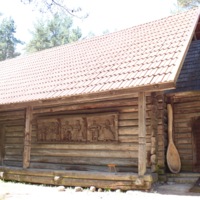Virtual Ethnographic Open-Air Museum of Latvia /
Virtuālais Latvijas Etnogrāfiskais Brīvdabas Muzejs
Title
Virtual Ethnographic Open-Air Museum of Latvia /
Virtuālais Latvijas Etnogrāfiskais Brīvdabas Muzejs
Virtuālais Latvijas Etnogrāfiskais Brīvdabas Muzejs
Description
Photographs, description texts, and results of surveys and interviews with museum professionals and visitors obtained at the Ethnographic Open-Air Museum in Latvia. This virtual exhibition is provided in English and Latvian.
The decision about the establishment of Open-Air Museum was accepted in 1924, but its first exhibition - Vidzeme Fisherman's Homestead – was open to public in 1932. Today 118 folk architecture objects are exhibited in the territory of 87ha on the Coast of Jugla Lake in Rīga.
The museum collects documents and preserves the objects of folk building monuments of Latvian historical and ethnographical regions, along with evidence of the way of life and culture of the rural population, characteristic to the period from the 17th century until 30-ies of the 20th century.
The museum researches, exhibits as a whole and promotes the monuments of traditional life, as well as educates and informs the society about the cultural heritage, work and daily life traditions and aesthetics of folks who have lived in the territory of Latvia.
At the museum you can:
- find out and learn about the history and development of crafts, technologies and traditions;
- experience the joy of dancing, singing, playing music and games;
- have a good time and meaningful day with your children, family, relatives, friends and contemporaries;
- observe and try out the old craft and taste the traditional food;
relax and enjoy being in nature;
- visit the applied folk art fair during the first weekend of June.
Fotogrāfijas, apraksti, un rezultāti no aptaujām un intervijām ar muzeja pārstāvjiem un apmeklētājiem, kuri tika apkopoti Etnogrāfiskajā Brīvdabas Muzejā Latvijā. Šī virtuālā ekspozīcija tiek piedāvāta Angļu un Latviešu valodās.
Lēmumu par Brīvdabas muzeja dibināšanu pieņēma 1924. gadā, bet 1932. gadā apmeklētājiem tika atvērta pirmā brīvdabas ekspozīcija Baltijā - Vidzemes sēta. Patlaban muzejs aizņem 87ha lielu platību priežu mežā Juglas ezera krastā. Uz muzeju pārvestas, uzstādītas un iekārtotas 118 senas celtnes no visiem vēsturiskajiem Latvijas novadiem – Kurzemes, Vidzemes, Zemgales un Latgales no 17. gadsimta beigām līdz 20. gadsimta 30. gadu otrajai pusei.
Muzejā izveidotas latviešu zemnieku, amatnieku un zvejnieku sētas. Visās apskatāma pastāvīgā ekspozīcija – sadzīves un darba priekšmeti, interjera iekārtojums, kas raksturo laika posmu, novadu un mājas saimnieku nodarbošanos. Apmeklētāji var iepazīties ar Kurzemē dzīvojošo lībiešu zvejnieku, Latgales krievu vecticībnieku saimniecībām.
Muzejā strādā amatnieki, svin latviešu gadskārtu ieražu svētkus, izstāžu zālē var skatīt tautas lietišķās mākslas studiju un muzeja krājuma materiālu izstādes.
The decision about the establishment of Open-Air Museum was accepted in 1924, but its first exhibition - Vidzeme Fisherman's Homestead – was open to public in 1932. Today 118 folk architecture objects are exhibited in the territory of 87ha on the Coast of Jugla Lake in Rīga.
The museum collects documents and preserves the objects of folk building monuments of Latvian historical and ethnographical regions, along with evidence of the way of life and culture of the rural population, characteristic to the period from the 17th century until 30-ies of the 20th century.
The museum researches, exhibits as a whole and promotes the monuments of traditional life, as well as educates and informs the society about the cultural heritage, work and daily life traditions and aesthetics of folks who have lived in the territory of Latvia.
At the museum you can:
- find out and learn about the history and development of crafts, technologies and traditions;
- experience the joy of dancing, singing, playing music and games;
- have a good time and meaningful day with your children, family, relatives, friends and contemporaries;
- observe and try out the old craft and taste the traditional food;
relax and enjoy being in nature;
- visit the applied folk art fair during the first weekend of June.
Fotogrāfijas, apraksti, un rezultāti no aptaujām un intervijām ar muzeja pārstāvjiem un apmeklētājiem, kuri tika apkopoti Etnogrāfiskajā Brīvdabas Muzejā Latvijā. Šī virtuālā ekspozīcija tiek piedāvāta Angļu un Latviešu valodās.
Lēmumu par Brīvdabas muzeja dibināšanu pieņēma 1924. gadā, bet 1932. gadā apmeklētājiem tika atvērta pirmā brīvdabas ekspozīcija Baltijā - Vidzemes sēta. Patlaban muzejs aizņem 87ha lielu platību priežu mežā Juglas ezera krastā. Uz muzeju pārvestas, uzstādītas un iekārtotas 118 senas celtnes no visiem vēsturiskajiem Latvijas novadiem – Kurzemes, Vidzemes, Zemgales un Latgales no 17. gadsimta beigām līdz 20. gadsimta 30. gadu otrajai pusei.
Muzejā izveidotas latviešu zemnieku, amatnieku un zvejnieku sētas. Visās apskatāma pastāvīgā ekspozīcija – sadzīves un darba priekšmeti, interjera iekārtojums, kas raksturo laika posmu, novadu un mājas saimnieku nodarbošanos. Apmeklētāji var iepazīties ar Kurzemē dzīvojošo lībiešu zvejnieku, Latgales krievu vecticībnieku saimniecībām.
Muzejā strādā amatnieki, svin latviešu gadskārtu ieražu svētkus, izstāžu zālē var skatīt tautas lietišķās mākslas studiju un muzeja krājuma materiālu izstādes.
Creator
V.Hainovska
Language
English / Latviešu
Collection Items
Main Entrance / Galvenā Ieeja
In the Ethnographic Open-Air museum of Latvia visitors have an opportunity to get acquainted with 118 objects of ancient dwelling from all four regions of Latvia – Vidzeme, Latgale, Kurzeme and Zemgale. Here it is possible to explore the traditional…
Laubere Estate Servant's Barn – Exhibition Hall / Lauders Muižas Kalpu Klēts – Izstāžu Zāle
The museum exhibition hall is arranged in Lubere estate servant’s barn built in the first half of the 19th century. It is open to the public during the summer season only.
Muzeja izstāžu zāle iekārtota 19. gs. pirmajā pusē celtajā Lauberes muižas…
Muzeja izstāžu zāle iekārtota 19. gs. pirmajā pusē celtajā Lauberes muižas…
Kurzeme Lutheran Church / Kurzemes Luterāņu Baznīca
Built in 1704-1705 in the former Renda parish of the district of Kuldīga near Usmas Lake as a branch of the Renda Lutheran parish. Re-erected in the museum in 1935.
On Sunday divine service and ceremonies such as christening, confirmation and…
On Sunday divine service and ceremonies such as christening, confirmation and…
Kurzeme Peasant's Homestead / Kurzemes Zemnieka Sēta
Farmsteads in the area of South Kurzeme are characterised by two courtyards: in the middle – a residential house, opposite of which – a cattle feedlot, between both buildings – a work or dirty yard.
Between the dwelling house and adjacently built…
Between the dwelling house and adjacently built…
Kurzeme Peasant's Homestead (Cattle Yard) / Kurzemes Zemnieka Sēta (Laidars)
The inhabitants of Kurzeme used to combine a cattle shed, livestock, feeding shed, cart-house and servant’s barn under the same roof. In the 19th century this farm had 5 horses, 12 cows, 20 sheep and 6 pigs.
At present, a working cart, two-wheel…
At present, a working cart, two-wheel…
Kurzeme Peasant's Homestead (Dwelling House) / Kurzemes Zemnieka Sēta (Dzīvojamā Ēka)
The type of construction, the layout and the outer appearance of the building is characteristic of the South West Kurzeme (Curland) rural wooden architecture of those days, up to the beginning of the 20th century.
In the centre of the house there…
In the centre of the house there…
Kurzeme Peasant's Homestead (Granary) / Kurzemes Zemnieka Sēta (Klēts)
Adorned with a porch, decorated pillars and doors the granary presents a building art monument typical for Kurzeme people.
In a grain granary there were storage containers for cereals, meat, honey, fat and other products, which were stored in jars…
In a grain granary there were storage containers for cereals, meat, honey, fat and other products, which were stored in jars…
Kurzeme Peasant's Homestead (Bathhouse) / Kurzemes Zemnieka Sēta (Pirts)
The structure consists of three divisions: small entrance passage or anteroom, dressing room and bathing chamber with boulder fireplace and sweating bench. Water in the tub was heated by immersing hot stones in it. The smoke was let off through the…
Kurzeme Smithy / Kurzemes Kalve
In the past a single room building with a clay tile roof was located at the roadside. Blacksmiths’ equipment: forge, bellows, hammer anvils, tongs, etc. Blacksmith tools are also displayed: hammers, pliers, and drills. Various tools and household…
Kurzeme Harbour Warehouse / Kurzemes Ostas Noliktava
A number of warehouses were built on the central banks of Liepāja port at the end of the 17th century. The warehouse “Bezdelīga” was transferred to the museum.
Blocks for load descent/ascent were equipped in the openings of roof windows. The first…
Blocks for load descent/ascent were equipped in the openings of roof windows. The first…
Zemgale Roadside Inn / Zemgales Priedes Krogs
Only manors were entitled to set up inns, which were built close to grinding-mills, churches, and main crossroads – the points of many people circulation. Coming back from the market farmers stayed at an inn for a night to have a meal and rest…
Zemgale Windmill / Zemgales Vējdzirnavas
The windmill belongs to the older type of windmills, the so-called pole type. The case rests on a 6,7m long oak pole – axis. There is a pair of millstones – attrition mill.
The lower stone weighs around 800 kg, the upper – twice more. To change the…
The lower stone weighs around 800 kg, the upper – twice more. To change the…
Vidzeme Fisherman's Homestead / Vidzemes Zvejnieka Sēta
The homestead consists of a fisherman’s houses transferred from the eastern coastline of the Gulf of Rīga. It reflects an average wealthy fisherman’s life style typical for the second half of the 19th century.
The main income was earned by fishing,…
The main income was earned by fishing,…
Vidzeme Peasant's Homestead / Vidzemes Zemnieka Sēta
The farmstead reflects the life style of an average wealthy peasant of Vidzeme in the period from the later half of the 18th century to the first half of the 19th century.
The buildings were grouped around the irregularly shaped courtyard with a…
The buildings were grouped around the irregularly shaped courtyard with a…
Vidzeme Threshing-Dwelling House and School / Vidzemes Dzīvojamā Rija – Skola
The building consists of a drying house, threshing room and chamber.
The school was set in the chamber (1704-1747), where children of peasants learnt reading, writing, numeracy, and religion. School lasted from the end of November till the…
The school was set in the chamber (1704-1747), where children of peasants learnt reading, writing, numeracy, and religion. School lasted from the end of November till the…
















